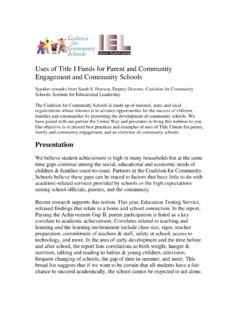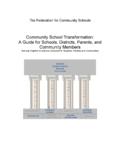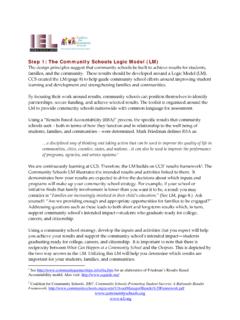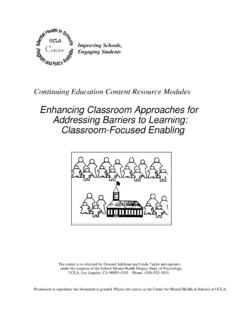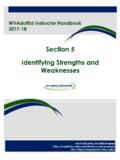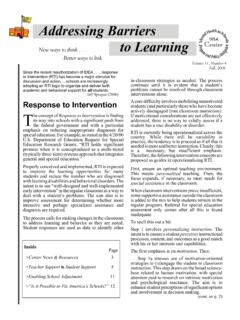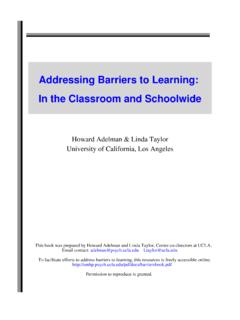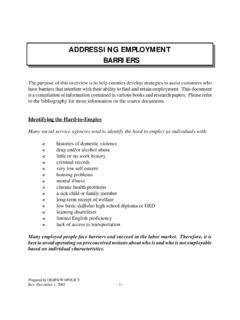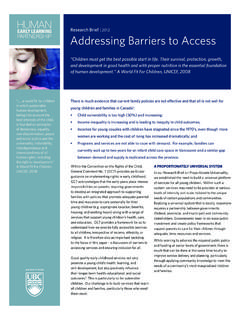Transcription of Addressing Barriers to Learning: A Set of Surveys …
1 A Resource Aid Packet onAddressing Barriers to Learning: A Set of Surveys to Map What a SchoolHas and What it Needs*The Center is co-directed by Howard Adelman and Linda Taylor and operates under the auspices of the School Mental Health Project, Dept. of Psychology, : Center for Mental Health in Schools, Box 951563, Los Angeles, CA 90095-1563 Phone: (310) 825-3634 | Fax: (310) 206-8716 | E-mail: | Website: comes in part from the Office of Adolescent Health, Maternal and Child Health Bureau (Title V, Social Security Act), Health Resources and Services Administration (Project #U45 MC 00175), Department of Health and Human reference this document as follows: Center for Mental Health in Schools at UCLA.
2 (2007). Aresource aid packet on Addressing Barriers to learning : A set of Surveys to map what a school has andwhat it Los Angeles, CA: June 2007 Copies may be downloaded from: If needed, copies may be ordered from:Center for Mental Health in SchoolsUCLA Dept. of Box 951563 Los Angeles, CA 90095-1563 The Center encourages widespread sharing of all school needs a learning support or enabling component that is well-integrated with its instructionalcomponent. Such an enabling component addresses Barriers tolearning and promotes healthy Resource Aid includes a discussion of comprehensive,integrated approaches for Addressing Barriers to learning .
3 Thispresentation is followed by a set of Surveys covering sixprogram areas and the leadership and coordination systemsevery school must evolve to enable learning effectively. Areascovered are (1) classroom-focused enabling, (2) crisisassistance and prevention, (3) support for transitions, (4) homeinvolvement in schooling, (5) student and family assistanceprograms and services, and (6) community outreach forinvolvement and support (including volunteers). In addition, there is a survey of mechanisms for leadership andcoordination of enabling activity, and a survey of School-Community learning Supports Complex Problems Require aComprehensive, Multifaceted, Cohesive Systemic Approach The complexity of factors interfering with learning and teaching underscore the need fora comprehensive, multifaceted, and cohesive system of learning supports.
4 The matterthen arises as to how to operationalize such an enabling/ learning supports this end, we offer a unifying framework that encompasses (1) an integrated and systemiccontinuum of interventions and (2) a multifaceted and cohesive set of content Continuum of Integrated School-communityIntervention Systems The intent, over time, is for schools to play a major role inestablishing a full range of integrated intervention systems, including systems for promoting healthy development and preventingproblems systems for intervening early to address problems as soonafter onset as is feasible systems for assisting with chronic and severe illustrated in Exhibit 1, the desired intervention systems can beconceived along a continuum.
5 In keeping with public education andpublic health perspectives, such a continuum encompasses efforts toenable academic, social, emotional, and physical development andaddress behavior, learning , and emotional problems at every schools have some programs and services that fit along theentire continuum. However, as stressed, the interventions are notcoalesced into integrated systems. Moreover, the tendency to focusmostly on the most severe problems has skewed the process so thattoo little is done to prevent and intervene early after the onset of aproblem. As a result, public education has been characterized as asystem that waits for failure.
6 The continuum spans the full spectrum of prevention efforts andincorporates a holistic and developmental emphasis that envelopsindividuals, families, and the contexts in which they live, work, andplay. The continuum also provides a framework for adhering to theprinciple of using the least restrictive and nonintrusive forms ofintervention required to appropriately respond to problems andaccommodate diversity. Moreover, given the likelihood that many problems are not discrete,the continuum can be designed to address root causes, therebyminimizing tendencies to develop separate programs for eachobserved problem.
7 In turn, this enables increased coordination andintegration of resources which can increase impact and cost-effectiveness. 3 Exhibit 1. Interconnected Systems for Meeting the Needs of All Students4 Designing theContinuum to FitSchoolImprovementEfforts Moving beyond the laundry listIn our work, we operationalize the continuum as part of theconcept of an enabling or learning supports component. This helpsto coalesce and enhance programs to ensure all students have anequal opportunity to succeed at school. A critical matter is definingwhat the entire school must do to enable all students to learn andall teachers to teach effectively.
8 School-wide approaches areespecially important where large numbers of students are affectedand at any school that is not yet paying adequate attention toequity and diversity efforts have further operationalized such a componentinto six programmatic arenas. In doing so, they have moved froma laundry list of programs, services, and activities to a definedcontent or curriculum framework that captures the essence of themultifaceted ways schools must address Barriers to 2 outlines the prototype for the six arenas of an enablingor learning support componentEncompassed are programs to regular classroom strategies to enable learning ( , improving instruction for students who havebecome disengaged from learning at school and for thosewith mild-moderate learning and behavior problems)
9 Transitions ( , assisting students and families asthey negotiate school and grade changes and many othertransitions) home and school to, and where feasible, prevent community involvement and support (outreachto develop greater community involvement and support,including enhanced use of volunteers) student and family access to effective servicesand special assistance as EnablingComponentExhibit 2. An Enabling Component to Address Barriers to learning and Enhance Healthy Development at a School SiteRange of Learners (categorized in terms of their response to academic instruction at any given point in time) I = Motivationally ready & able No Barriers Instructional Component(2) (a) Classroom Desired Not very Teaching Outcomes motivated/ + lacking Barriers (b)
10 Enrichment prerequisite to Activity II = knowledge learning & skills/ different learning rates & styles/minor vulnerabilities (1) Avoidant/ Component to Enable learning : very deficient A Comprehensive, Multifaceted Approach in current for Addressing Barriers to LearningIII = capabilities/ has a disability/ Such an approach weaves six clusters of enabling major health activity ( , an enabling component curriculum) into problems the fabric of the school to address Barriers to learning and promote healthy development for all students.


